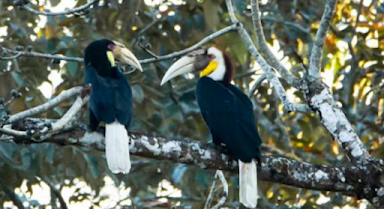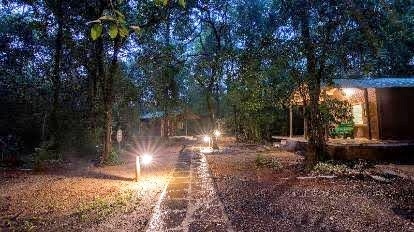Hornbill Story.
I had just shifted to Manipal and there was a beautiful valley of trees just below my balcony, it was really an amazing view as I saw the valley as a huge forest as far as my eyes could see and it ended with the Arabian Sea, which was around ten kilometers away. On a clear day I could see the beach and the parasailing activities in the horizon. It was a wonderful exposure to nature as there was a constant parade of monkeys marching through my balcony and fly past of different varieties of birds.
Now living above a forest meant that there was absolute peace as all I could hear was the sound of toads and crickets along with the splitter and spatter of rains in the night. I woke up in the morning to the sound of “eew” made by the snobbish peacocks who had probably discovered something disgusting in the morning. They were always hanging by on the electrical tower and seemed to be an elite group. There were lot of different bird chirps which I could hear and identified a few as I could easily spot the Kingfisher and the smaller sparrow sized birds, interestingly the sparrow which was previously so common has now completely vanished due to many reasons and for conservation purpose it was declared as the state bird of Delhi in 2012 as well as recognized as an endangered species.
There was however the sound of a small puppy yelping out loudly and I could clearly make out that it was a bird but could not identify the bird. This was something new to my ears and what my eyes would see later was totally unexpected – I saw the bird one day at a distance and found it very strange as it had a huge hornlike casque above its bill and it looked awesome when it flew with its white striped wings. That was the beginning of my obsession with the Hornbill as I quickly recalled seeing this strange bird in many pictures and videos. It was the logo of Bombay Natural History Society.
Now a lot of questions came up in my mind as to why the bird was crying out so loudly and what was it trying to prove to the world at large. Where did it stay and with how many other birds did it mate with, what sort of a society did the birds have, were they monogamous or polygamous, who looked after the task of raising the young birds – was it a poor single mother raising the child while the father carelessly gallavanted about with other birds, what was their nest like and how long did they live and what did they eat.
The best way to know more about the bird was from my reliable sources called Google and it gave me a lot of interesting information about Hornbill and the Book of Indian Birds by Dr Salim Ali was very insightful. This is what I discovered after reading about Hornbills – the bird was literally shouting to declare its territory which was probably a lot of square kilometers as the screeching could be heard a kilometer away, the other reason was probably to attract a female and also show how healthy it was with its loud screeching. I thought of all the loud bullies trying to get female attention in human society, but I guess they were not all that successful.
Lady hornbills are trusting wives, and gentle-men hornbills are the most faithful husbands. There was something very curious which I read in the book – the female hornbill instinctively walls herself with mud, collected by the male, into a hole near the top of some high jungle tree for two months or more to hatch the chicks and is fed through an aperture by the male hornbill. Food is mostly fruits, insects and lizards and the foraging male passes food to his imprisoned mate once an hour and I saw some cute videos of hornbills feeding the female on YouTube.
Hornbills mate for life and apparently their conjugal life is a model of high morality. Walled into the tree holes the females obviously are helpless to protect themselves against any infidelity, and sad to say, there are vampire female hornbills whose only thought is to steal some imprisoned lady’s spouse. I got to know that despite all this attempt to steal the affection the male preserved his virtue till the end.
This is a short story about Hornbill found in a journal of BNHS - "By November 8 [he records], the female was walled in, and a more serious attempt at interference was now made by a foreign female. . . . She was following the male and lighted in the next tree when he lighted above his nest hole. On November 23 the same course of events took place, except that the male was less tolerant. He fed his own mate, then drove the intruder away. A week later I saw her fly in close behind the male and light 25 feet from the nest hole. The male gave his mate a piece of bark followed by some fruit, and then bounced from one branch to another toward the foreign female. The poor fellow was falling, falling, but the female within the nest screamed a number of times. I wondered whether the interloper could seduce the male, but from subsequent observations it seemed unlikely that she would. The male returned again to the nest hole, and a few minutes later was in the upper part of the tree knocking about on dead branches until he dislodged a piece of bark. He clamped his bill on the bark until it was largely fragmented. Then he moved toward the foreign female. If he presented the bark [a cherished play object among hornbills] one would suppose that she had some attraction for him. After a moment, however, he changed his direction, flew down to the big limb below, bent over the nest hole, and gave the token to his mate, accompanied by a feeding chuckle. Subsequently he returned to perch quietly within eight feet of the intruding female. At 7.30 a.m. the two of them flew away together. As the nesting season progressed, he became less tolerant of her intrusions. . . . On February 3 I again watched her fly in behind the male and alight on the nest tree, making considerable noise. The male stopped feeding his mate, swooped at the interloper and drove her down toward the ground. However, when he flew away, she followed a short distance behind. The vampire was hard to discourage. A few days later she was observed at the entrance to the nest, trying to break the wall with her beak. Probably there was a sex murder case in the making. But "after five minutes the male arrived and . . . drove the foreign female to another tree, flying at her so hard that he knocked leaves from intervening branches. He returned to his nest with a small stick held like a cigar. His mate, who had remained silent, now began her wailing screeches. . . . The intruding female, persistent as usual . . . had followed the male back to the nest tree. In a few minutes he flew at her again, flying faster than hornbills usually do as he chased her from one tree to another." But his ordeal of bachelorhood was nearly over. Five days later mother and young emerged from the nest. "The pair of hornbills were perched side by side on their nest tree. Not long after I heard a great flutter of wings. I looked back to see both members of the pair pursuing a foreign female. . . . When the parents later came to our garden, she did not follow.”

Well I saw the re-enactment of the same story from my balcony and tried to photograph the lovely couple and the baby birds but due to distance the photos did not come out clear.
The Hornbills have a major role to play in dispersal of seeds and forestation as they live up to forty years and it is a peculiarly awesome bird worth observing and really beautiful to look at. I learned a lot about the birds and bees and their role in cross pollination and keeping the fragile forests alive. We need to conserve and protect birds for preserving our forests and our fragile planet.










Comments
Post a Comment